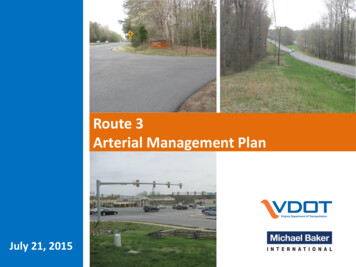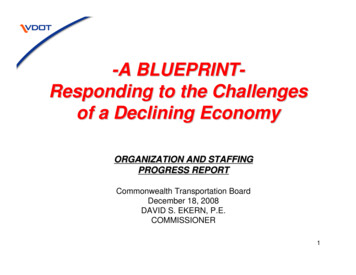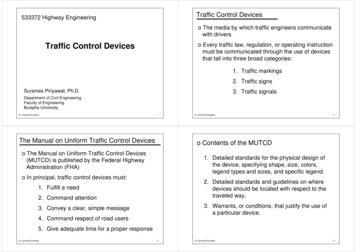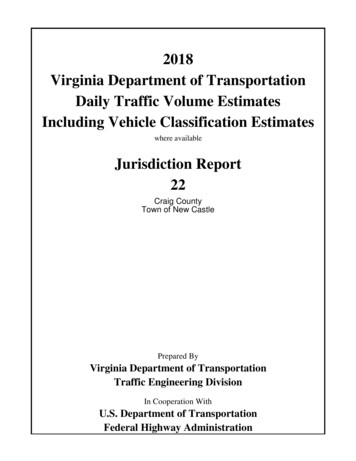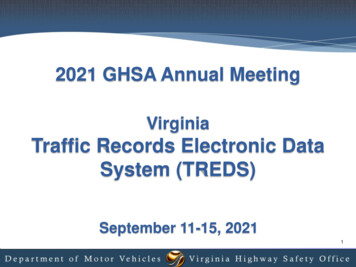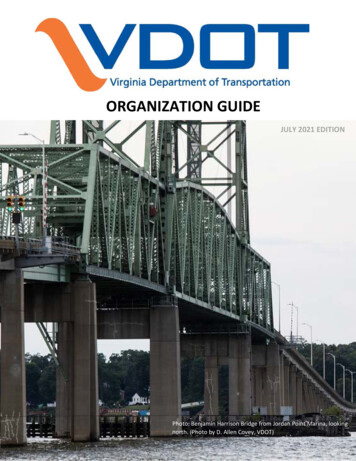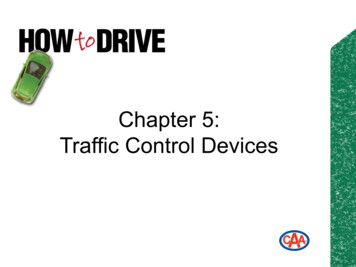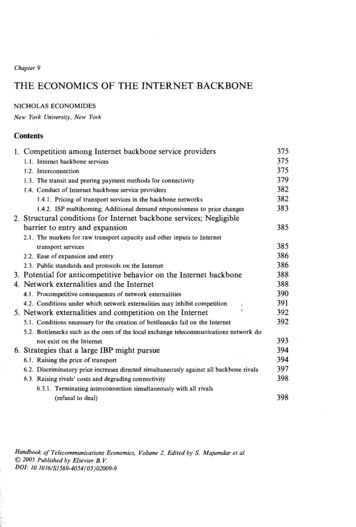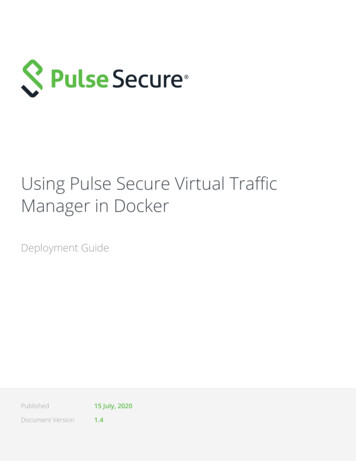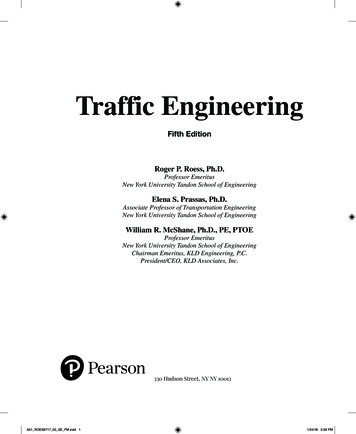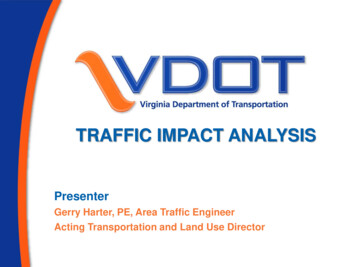
Transcription
TRAFFIC IMPACT ANALYSISPresenterGerry Harter, PE, Area Traffic EngineerActing Transportation and Land Use Director
Why a TIA? Roads are a critical public resource and a major investment ofpublic funds Traffic impacts from trips generated by development can causedisruption in traffic flow and traffic congestion which can lead toroads becoming less safe. TIAs help to ensure development impacts do not overburden thetaxpayer. TIAs can be applied by public officials to balance:oProperty owners right to access the highway to use their landoRoadway users right to mobility, safety, and efficientexpenditure of public funds.2
So taxpayersdo not have topay for this.TIA Study todeterminehow toprevent this3
Benefit of the TIA Study to the CommunityTurn lanes and tapers –Maintain through traffic flow.4
Benefit of the TIA Study to the CommunityEntrances away from intersections and interchange rampsIntersection signalR-O-W for road wideningImprove sight distanceInterparcel connectionEntrance designSubdivision connectivityConsolidate existing entrances.5
TIA Touch Points During Local Land Use Actions Chapter 527 VDOT Permitting ProcessLocal LUA527/TIAPermits6
Local Land Use Approval ProcessThe rezoning of property is the earliest point in the localland review process that offers flexibility in design details By evaluating the proposal Impacts on the transportation network can be identified Measures to address the impacts can be determined Locality can request a TIA at this stage. GREAT TIME FOR VDOT PARTNERING! Conditional zoning - opportunity for applicant to profferboth on-site and off-site transportation improvementsto mitigate impacts – GREAT TIME FOR VDOTPARTNERING7
Local Land Use Approval ProcessSite plan and subdivision plat review Examine details on the design and layout of thedevelopment GREAT TIME FOR VDOT PARTNERING!VDOT offers assistance to localities in the review of: The transportation portion of comprehensive plans Rezoning requests, and Site plans and subdivision plats.AT THIS STAGE, VDOT IS ADVISORY ONLY8
Chapter 527 - Traffic ImpactAnalysisLand development proposals to be submitted “Substantially affect transportation on state controlled highways”based on traffic volume– 5,000 trips per day (standard threshold)– 400 trips per day and at least equals existing traffic on road (for residentialdevelopment only, low volume road threshold) Dependent upon– Submission type Comprehensive Plan or Plan Amendment Rezoning or Special Use Permit– Location Within 3,000 ft of connection to VDOT highway (for non-VDOT localities) Exception: Rezoning that does not increase trips (daily and peak hour)over those allowed under existing zoning9
Traffic Impact AnalysisSample Developments That May Meet ThresholdsITE Land UseDescriptionResidentialSingle Family DetachedApartmentOtherLight IndustrialHigh SchoolHospitalGeneral Office BuildingShopping CenterHome Improvement SuperstoreCodeVariableLow Volume(400 Trips)Standard(5,000 Trips)210220dwelling unitsdwelling units40 du60 du550 du670 du110530610710820862square feetstudentsbedssquare feetsquare feetsquare feetnot applicablenot applicablenot applicablenot applicablenot applicablenot applicable690,000 sf2,900 st420 bds560,000 sf40,000 sf170,000 sfThese are estimates that have been rounded and are not official thresholds. They are offered as examples only.10
Chapter 527 TIA Regulations A 527 TIA study prepared per the methodology can still berequested by the locality. VDOT will provide a written response to locality/developer: Summarize key findings of the study Comments on recommended highway improvements Advise on needed compliance with other VDOT regulations Comments on suggested improvements to other travel modes.11
527 -Traffic Impact Analysis Comp plan submission not required to include TIA; rezoning isrequired to include a TIA Published local study standards can be used, if certified byDistrict Scope of study dependent upon amount of traffic generated butgenerally includes:– Existing and proposed land use– Existing traffic and Level of Service (LOS)– Expected future traffic and LOS (without proposed development)– Expected future traffic and LOS (with proposed development)– Recommendations for traffic impact mitigation measures12
Traffic Impact AnalysisRequired elements (cont’d) Default assumptions and methodology– Data collection (avoid holidays, inclement weather)– Trip generation (rates vs. equations based upon ITE methodology)– Internal capture rates (residential with others, hotel with office,office with retail)– Pass-by trip rates (per ITE Trip Generation Handbook)– Allow alternate trip generation for “Small Area Plans” (EPA-MXDmethodology)– Level of service calculation (HCM methodology for vehicles,Transit Capacity and Quality of Service Manual for transit)– Modal split (bike/ped facilities, proximity to transit service)24VAC30-155-6013
VDOT Permitting ProcessPermits allow users to perform work within our roadwaysand rights of ways.1. A permit is required for any type of utility activity occurring withinthe right-of-way.2. A permit is required to install any entrance onto a state highway.3. A permit is required to perform surveying operations within theright-of-way.4. A permit is required for any agricultural and commercial use andoccupancy of the right-of-way.5. A permit is required for any miscellaneous activity or use of theright-of-way except for mailboxes and newspaper boxes (see24VAC30-151-560) and public service signs (24VAC30-151-570).14
TIAs and Entrance Permits What is the relationship between TIAsand commercial entrance permits? VDOT can request a TIA in order to determineimpacts of development during the permittingprocess. 24VAC30-73-70 Commercial Entrance Design At the request of the district , the permit applicant shallfurnish a report that documents the impact of expectedtraffic movements ”15
TIAs During Permit Stage If VDOT has not heard about the project until the permit stage, itis more difficult to plan appropriate mitigation measures fortransportation impacts. Many times the site plans, rezonings, CUPs, and subdivisionshave already been approved by the planning commission and/orthe governing body making changes to the site plan difficult. Typically, local governments are disengaged at this stage sincethey have completed all of their processes. Causes unnecessary delays in commercial entrance permitapproval process. More costs and time at end of process when developer wasleast expecting it.16
TIAs During Permit StageSuggestions Engage VDOT as a partner in the process as early as possible. If a TIA is needed to mitigate impacts, have the landdevelopment applicant prepare it earlier in the process. Also, ensure that it meets VDOT’s expectations as well so thatall information is provided avoiding additional delays. VDOT is available in an advisory role and would be happy toassist during the land use action.17
Conclusion TIAs are vital to the mobility and safety of the travelling public TIAs provide information to help ensure that developmentmitigates their impacts on the road system. TIAs are required for Chapter 527 rezonings, Should be part of the local land development review process, May be required by VDOT during entrance permit review. Chapter 527 provides a thorough traffic impact analysismethodology for rezonings that fall under 527. Localities can request TIAs for non-527 land use actions. TIA methodology can be different for non-527 developments. The traffic impacts of development should be considered asearly in the process as possible.18
QUESTIONS / COMMENTSFor more information on the state law, regulationsand traffic impact analysis studiesSee the VDOT web site, Info Center tab, Transportation andLand Use19
Why a TIA? Roads are a critical public resource and a major investment of public funds Traffic impacts from trips generated by development can cause disruption in traffic flow and traffic congestion which can lead to roads becoming less safe. TIAs help to ensure development impacts do not overburden the taxpayer.
